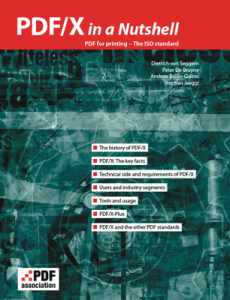
Technical side and requirements of PDF/X
Even as the first part of PDF/X was published as ISO 15930-1 in 2001, others were already in development. PDF/X rapidly expanded into a fami.ly of standards supporting a wide variety of print production workflows. Each part of PDF/X builds on a previous part, providing flexibility while ensuring reliable exchange, the core rationale for PDF/X. PDF/X-1a: Complete exchange PDF/X-1a was the first and most restrictive member of the PDF/X family. PDF/X-1a aims for “complete exchange”; a single file m … Read more
Even as the first part of PDF/X was published as ISO 15930-1 in 2001, others were already in development. PDF/X rapidly expanded into a fami.ly of standards supporting a wide variety of print production workflows. Each part of PDF/X builds on a previous part, providing flexibility while ensuring reliable exchange, the core rationale for PDF/X.
PDF/X-1a: Complete exchange
PDF/X-1a was the first and most restrictive member of the PDF/X family. PDF/X-1a aims for “complete exchange”; a single file must contain all information needed for printing the document as intended by the sender.
The core principles are the same as in all PDF/X standard parts: all fonts must be embedded and external data, password protection, visible annotations and JavaScript are not allowed (see “PDF/X: The key facts”). Other requirements are specific to PDF/X-1a, e.g. those pertaining to transparency and layers which later (in PDF/X-4, see below) are permitted.
Additionally, printing a PDF/X-1a file must be possible without requiring prior color correction. Therefore, print elements can only use CMYK, greyscale or spot colors; no RGB or device-independent color spaces are permitted.
This implies that CMYK or greyscale elements must have been prepared for the intended output process as specified in an Output Intent, which consists largely of an ICC profile characterizing the intended print process. The use of standard Output Intents facilitates the standardized data exchange that is the objective of PDF/X.
PDF/X-3: Color management
PDF/X-3, originally published in 2002, shares most of its requirements with PDF/X-1a, but it lifts the restriction to CMYK and spot colors. In PDF/X-3, graphics can use CMYK, greyscale, RGB, Lab and ICC based color spaces. It requires, however, that device color spaces may be used only if the same color space is used for the ICC profile in the Output Intent, so DeviceRGB requires the Output Intent to use an RGB ICC profile. Since this is usually not the case, as a practical matter, only ICC based RGB or CalRGB are permitted. Accordingly, the faithful reproduction of PDF/X-3 documents requires a color managed workflow.
PDF/X-2: Partial exchange
The strict requirement of including all resources inside a single file is not appropriate for every workflow. PDF/X-2 addresses this need; it allows the use of proxy elements referencing external graphics. Otherwise, PDF/X-2 is the same as PDF/X-3, so it allows color managed elements next to spot colors and device colors prepared for the specified output intent.
PDF/X-4: Transparency
The previous PDF/X variants do not support the features of more modern (beyond PDF 1.4) versions of PDF. By 2008, it was time to bring PDF/X up to date with current PDF specifications.
PDF/X-4 is based on PDF 1.6, published in 2004. This specification added support for new features, including layers, JPEG2000, OpenType fonts, and 16-bit images. In addition, PDF/X-4 allows the use of transparency, a PDF 1.4 feature forbidden in PDF/X until PDF/X-4.
PDF/X-4 includes two variations known as “conformance levels”: PDF/X-4 and PDF/X-4p.
- PDF/X-4 inherits the rules of PDF/X-3 for complete exchange in color managed workflows, with the requirement of always embedding the output intent ICC profile.
- PDF/X-4p provides a form of partial exchange; it allows the ICC profile to be maintained externally. This ensures better efficiency in workflows where many files share the same output intent, or where embedding the ICC profile would substantially increase the file size.
PDF/X-5: More flexibility
PDF/X-5 is a set of three conformance levels, all geared towards different workflows. Each conformance level expands on PDF/X-4 or PDF/X-4p.
- PDF/X-5n allows for n-colorant color spaces that are used where the traditional four print process colors (CMYK) are not enough. n-colorant color spaces may be required to enable a larger color gamut (e.g. CMYK plus Green, Violet, Orange) to allow for more accurate skin tones, pastel colors or the like. Another use of PDF/X-5n is in packaging, in which certain product-specific spot colors are also used for imagery as process colors. In any such case an n-colorant ICC profile must be specified in the Output Intent; it can either be referenced as in PDF/X-4p, or as an embedded file.
- PDF/X-5g extends the PDF/X-4 standard with the ability to use external raster and vector graphics. Like the older PDF/X-2, a PDF/X-5g file can contain temporary placeholders that reference an external resource.
- PDF/X-5pg takes PDF/X-5g one step further. It offers the same method for external graphics as PDF/X-5g, and combines it with the PDF/X-4p’s option of the output intent referenced as an external ICC profile.
PDF/X-6: Building on PDF 2.0
PDF/X-6 is currently under development within the ISO committee that manages the PDF/X specification. PDF/X-6 will relax some requirements, but the main difference as compared to previous PDF/X standards is that it will be based on ISO 32000-2, better known as PDF 2.0.
New to PDF 2.0 are page level Output Intents and better support for multichannel print color spaces (more channels than just CMYK) as is increasingly used in packaging or on digital printing devices. Annotations may be used within the print area if they have a printable appearance that complies with the same requirements as any other page content.




